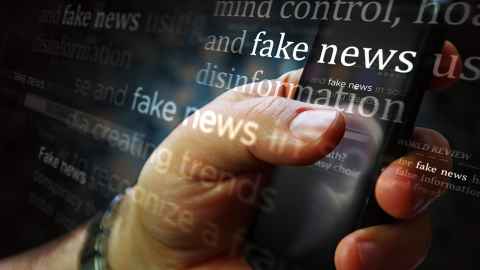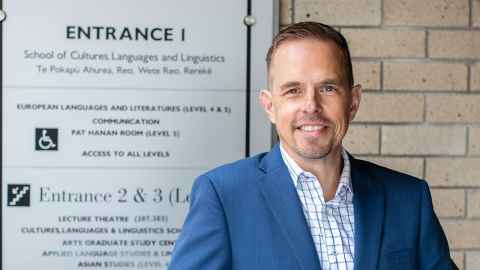Luke Goode's seven tips to spot fake news
22 May 2023
The phrase 'fake news' is as old as the news itself. But these days it can be difficult to spot. Associate Professor Luke Goode has seven tips to help.

‘Fake news’ is a troublesome phrase. It covers everything from deliberate disinformation to misleading information caused by sloppy journalism. It’s a convenient shorthand, but hides a diversity of forms, causes and consequences.
It’s also uncomfortable using a phrase that Donald Trump and other populists mobilised to corrode public trust in journalism and experts. Rather than encouraging healthy scepticism and critical thinking, ‘fake news’ post-2016 became the standard kneejerk comeback against unfavourable coverage: a weapon against critical thinking.
The phrase obscures the need for critical thinking and media literacy skills beyond true/false binaries. But news is rarely either genuine or fake. Literacy skills must plumb the murkier waters of spin and framing: an article devoid of falsehoods can still be deceptive in its selection and presentation of facts.
Fabricated ‘facts’ and misleading information blight our news ecosystem, one that includes the sources of fake news but also the billions of us online who can unwittingly spread and amplify it. Even AI chatbots have been in the spotlight for ‘hallucinating’ facts.
Luke Goode presents seven common-sense principles to boost your BS filters.
1. Humility
We’re all vulnerable to a basic cognitive bias: and recognising we can all benefit from more thoughtful news consumption habits is an important first step. Accessing reputable sources beyond our own ideological bubble also reduces the chances of swallowing narratives just because they fit our world view.

2. Context
Before we worry about being deliberately misled, we can avoid getting the wrong end of the stick by pausing to ask ourselves whether the information in front of us is packaged as news, opinion, advertorial or satire. Reputable news outlets label accordingly. While we can also develop skills to detect whether an article is little more than a paraphrased press release from a vested interest, the burden of sorting news from opinion or diligent journalism from rehashed press releases shouldn’t fall solely on individuals. Yet wherever these lines appear blurry, we can at least take this as our cue to handle information with care.
3. Reading below the fold
While broadsheet newspapers no longer reign supreme, this quaint phrase resonates even more strongly now. Digital business models incentivise clickbait headlines and sensational lead paragraphs. As audiences, we’re primed to skim and scan at speed. But more careful reading practices are another obvious way to avoid getting the wrong end of the stick.
4. Reputable sources
Established media brands have more to lose by publishing false information and are more likely to resource the necessary checks and balances. This doesn’t mean independent and alternative media should be mistrusted out of hand. They can be an important complement to the perspectives provided by mainstream media. For sources quoted within stories, red flags include unnamed sources (a staple of political journalism); experts proclaiming outside their own discipline, and “experts” you’ve never heard of and whose credentials you can’t establish with a quick online search.
Judging source credibility shouldn’t fall entirely to audiences, but wherever it isn’t readily visible, we should exercise caution.
We can avoid getting the wrong end of the stick by pausing to ask ourselves whether the information in front of us is packaged as news, opinion, advertorial or satire.
5. Triangulation
We should use the technology at our fingertips to seek verification from other (trusted) sources whenever we’re confronted with startling, scandalous or sensational information. But there’s a caveat, which leads us to #6…
6. Technological bias
Finding information repeated on the first page of a Google search or in our social media feeds doesn’t amount to verification.
In the early days of Google’s search-engine dominance, experts highlighting its biases were largely voices in the wilderness. Today, there’s wider public awareness of the non-neutrality of search tools, social media algorithms and new tools like ChatGPT. Yet we’re still liable to imagine an algorithm must be more neutral than a human editor could be.
The point is not to disbelieve everything in front of our eyes (a horrible way to live), but we can become more discerning users of these tools when we keep in mind how they can make factual errors and reproduce human prejudices.
7. A sense of perspective
Fake news is as old as news itself, even if the phrase only came to prominence through Trump in 2016. While it will likely mutate into new forms we can scarcely imagine, it won’t disappear. The problem won’t be magically solved by technologies developed to filter it out or through increased media literacy – though both may play a role.
Moreover, democracy’s problems run much deeper than fake news. Even if we could somehow solve fake news, democracy would still face major challenges on multiple fronts.
This tip is less about how to spot fake news and more about the risk of it dominating our field of vision and diverting our attention from other important challenges.
So, maybe I cheated. Maybe the headline is fake news. I only hope you read below the fold.
Associate Professor Luke Goode is the programme director for Communication in the Faculty of Arts.
This article first appeared in the Autumn 2023 edition of Ingenio.